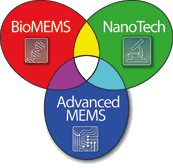- Nanotechnology for Health-Care and Diagnostics
- Macromolecular Structures@Sapienza
- Francesca Costantini CV
- Contacts
- Research
What is Nanotechnology?
Nanoscience and nanotechnology are the study and application of extremely small things and can be used across all the other science fields, such as chemistry, biology, physics, materials science, and engineering.
The ideas and concepts behind nanoscience and nanotechnology started with a talk entitled “There’s Plenty of Room at the Bottom” by physicist Richard Feynman at an American Physical Society meeting at the California Institute of Technology (CalTech) on December 29, 1959, long before the term nanotechnology was used. In his talk, Feynman described a process in which scientists would be able to manipulate and control individual atoms and molecules. Over a decade later, in his explorations of ultraprecision machining, Professor Norio Taniguchi coined the term nanotechnology. It wasn't until 1981, with the development of the scanning tunneling microscope that could "see" individual atoms, that modern Nanotechnology began.
Nanotechnology for Health-Care and Diagnostics

Recent developments in nanotechnology have opened up possibilities for new, revolutionary approaches to the analysis of individual molecules on the atomic scale, and the potential for the assembly of molecular structures and devices that are a few to tens of nanometers in size. This approach makes use of various biological research areas such as molecular self-assembly, spatial positioning, microconstruction, biocomposite fabrication and nanomachines. Therefore, nanobiotechnology, a new discipline that employs biomolecules as building blocks and biomolecular self-assembly as one of the construction methods combined with microfabbrication, offers exciting possibilities for the miniaturization of analytical instruments.
Microelectrochemical Systems (MEMS) based on microfabrication technologies can be widely used in many fields, which have all contributed to the rapidly growing miniaturization of biotechnological and chemical processes. Micro total analysis system (μ-TAS), sometimes called ‘lab-on-chip’, must perform the functions of large analytical devices in small units (Kopf-Sill 2002). When fully developed, μ-TAS will contain elements for the acquisition, pretreatment, separation, post-treatment and detection of a variety of samples. In this context, devices in which nanobiotechnology is combined with lab-on-chip for a wide range of applications such as in genomics, proteomics, clinical diagnostics, drug discovery and biosensors have appears.